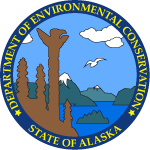| Action Date |
Action |
Description |
DEC Staff |
| 11/20/2009 |
Site Added to Database |
A new site has been added to the database |
Mitzi Read |
| 12/1/2009 |
Update or Other Action |
Site Closure Request submitted on 10/13/09. This site is the result of a fuel discharge from the hospital footing drains. The hospital was built on the site of a former bulk fuel tank farm, and vehicle maintanence garage. Footing drains began discharging fuel during hospital construction. An oil water separator was installed, but it was overwhelmed during a storm event. A larger oil water separator was later installed. Contaminated soil excavated during construction of the hospital foundation was placed in area 5. Soil samples collected in 1992, and 1997 exceeded the Method 3 Cleanup levels (ACLs)calculated for this site.
Recent groundwater samples have not detected contamination, but the closest monitoring wells are approximately 300 feet downgradient. The site closure request was denied, evidence that soil meets the ACLs and groundwater near the contaminated soil from the hospital foundation, meets Table C cleanup levels will be required prior to site closure. |
Kim DeRuyter |
| 10/8/2014 |
Site Characterization Report Approved |
ADEC received the Area 5 Site Characterization Report on May 5, 2014. The report describes the installation and sampling of a groundwater monitoring well and soil sampling activities that occurred in October of 2012. Results of these efforts show that there are concentrations of diesel-range organics (DRO) present in the groundwater and the soil at concentrations that exceed ADEC cleanup levels. Although the vertical extent of the contamination appears to be fairly well delineated at the site, the horizontal extent requires further fieldwork to establish. Once the extent of the contamination is adequately delineated, the recommendation is to excavate the contaminated soil to the point where two feet or less depth of contaminated soil remains. The excavated soil would be transported to the Remedial Treatment Area (RTA/Area 10) for land farming and the remaining onsite contaminated soil would be land farmed in place. |
Meredith Savage |
| 12/30/2014 |
Document, Report, or Work plan Review - other |
Received on 12/12/2014 the Draft Area 5 Soil Remediation Work Plan, Kanakanak Hospital (electronic copy). |
Meredith Savage |
| 3/4/2015 |
Document, Report, or Work plan Review - other |
The Alaska Department of Environmental Conservation (ADEC) received the final report titled Area 5 Soil Remediation Work Plan on February 2, 2015. The work plan describes the activities planned to address the cleanup of petroleum hydrocarbon contamination in an approximately one-acre area known as Area 5 within the Kanakanak Hospital complex. Diesel range organics (DRO) is the primary contaminant of concern at this site. The most heavily contaminated soil will be transported to the Area 10 Remediation Treatment Area (RTA) for landfarming and the remainder of the contaminated soil will be landfarmed within Area 5. |
Meredith Savage |
| 4/20/2015 |
Update or Other Action |
Excavated volumes of contaminated soil from Area 5 are larger than anticipated and the extent of contamination is deeper than expected. Groundwater is starting to fill deeper parts of excavation. |
Meredith Savage |
| 5/26/2015 |
Update or Other Action |
DEC will allow backfilling of site where excavation cannot continue due to groundwater intrusion; dewatering will not be required. Land farming can commence. |
Meredith Savage |
| 6/30/2015 |
Update or Other Action |
Biogenic interference was encountered at the Area 5 excavation. John Halverson of DEC agreed with the following recommendations of the project manager: (1)Excavate additional areas that exhibited elevated DRO concentrations well above the alternative cleanup levels (ACLs) as site access, soil conditions, and funding allow. (2)Soils where existing data indicate that RRO is present at concentrations above the alternative cleanup levels (but DRO is not) will be left in place. |
Joy Whitsel |
| 8/7/2015 |
Update or Other Action |
Transfer to Fairbanks |
Susan Carberry |
| 8/13/2015 |
Site Visit |
Conducted site investigation of Areas 3, 5, 10, and 12 and all monitoring wells. Work at Areas 3 and 12 is going according to plan. Area 10 remedial treatment area (RTA) has completed 8 tilling events according to the work plan but additional tilling events will be required because soil has not yet reached alternative cleanup levels (ACLs). Area 5 excavation has contaminated soil that needs to be excavated, but the area is too wet for equipment due to consistent flow of water from building footer drain. Drain should be diverted, which will hopefully allow water to subside and excavation activities to continue. |
Joy Whitsel |
| 9/9/2015 |
Update or Other Action |
Discussed disposition of water in Area 5 excavation pit with contractor, ERM. Analytical samples will be taken from Building 401 footer drain that is discharging to Area 5 and will be analyzed for VOCs, PAH, DRO, TAH and TAqH. Samples of water taken from Area 5 excavation pit in August were below cleanup levels for surface water and groundwater. Agreed with ERM that de-watering will not occur in order to complete excavation; rather, coarse fill will be placed in the pit past the water line to allow a working surface for additional excavation. |
Joy Whitsel |
| 10/15/2015 |
Update or Other Action |
ADEC requested that berms be added around the contaminated soil stockpile in Area 5 to prevent the potential for stormwater runoff from the stockpile to the Nushagak River. However, enough funds are available at present to either fill in the excavation at Area 5 or to add berms. Filling in the excavation and adding a trench downgradient of the excavation for stormwater accumulation/infiltration is the option most protective of the environment with the funds currently available. Therefore, no berms will be included around the stockpile at Area 5 at this time. The stockpile is currently covered with 6mm poly liner and is surrounded by wattles. |
Joy Whitsel |
| 10/19/2016 |
Site Characterization Report Approved |
DEC approved the Kanakanak Hospital Monitoring Work Plan. The work plan describes monitoring to be conducted on the Dental Clinic and Administrative Office (DAO) footer drain, the Building 401 footer drain, vapor intrusion system performance monitoring of the DAO, and multi-increment sampling from the Remediation Treatment Area at the Kanakanak Hospital campus in Dillingham, Alaska. |
Joy Whitsel |
| 9/28/2017 |
Site Visit |
DEC conducted a site visit of Kanakanak Hospital, focusing on the vapor mitigation measures taken at the DAO (Area 3), regrading of Area 5 and cleaning of the oil water separator, construction of the Area 6 landfarm, the adjacent Area 12 landfarm, and the Area 10 landfarm. A trip report documenting observations recorded during the site visit was provided to IHS and BBAHC. In general, all work was proceeding according to the applicable work plans and was protective of human health and the environment. One exception was the lack of berms present around the Area 10 landfarm to prevent runoff of contaminated soil. A letter was sent to IHS requesting corrective action. |
Joy Whitsel |
| 7/3/2018 |
Document, Report, or Work plan Review - other |
DEC approves the Area 5 Interim Soil Remediation Report (October 2017). The document discusses results from soil remediation activities completed in 2015 at Area 5, Area 10 and Area 6 of the IHS Kanakanak Hospital campus near Dillingham, Alaska. Recommendations for continued remediation efforts from the report were; resume excavation at Area 5, install three well points in conjunction with backfill operations at Area 5, continue monitoring the landfarm at Area 10 by collecting additional multi-incremental (MI) samples, and complete construction of the Area 6 landfarm with future remediation efforts. Remediation work at the IHS Kanakanak Hospital sites is ongoing. |
Erica Blake |
| 8/2/2018 |
Document, Report, or Work plan Review - other |
DEC approved the 2016 Fall Kanakanak Hospital Monitoring Report, dated July 23, 2018. The report describes monitoring activities at Area 5 (monitoring the footer drain from Building 401), Area 3 (vapor intrusion system performance monitoring for the Dental and Administrative Offices), and Area 10 (multi-incremental sampling at the landfarm). The 2016 report recommends the Oil-Water Separator be cleaned to prevent sediment from accumulating in the Bldg 401 footer drain. Vapor intrusion results from the Dental and Administrative Offices (DAO) were below the commercial indoor air target levels for volatile organic compounds (VOCs). Multi-incremental results at Area 10 indicated the fifth layer of contaminated soil has been treated to contaminant levels below the alternate cleanup level for diesel range organics (DRO). Concentrations still remain above 18 AAC 75 Table B2 values. Monitoring of these areas is expected to continue. |
Erica Blake |
| 8/2/2018 |
Document, Report, or Work plan Review - other |
DEC approved the February 2018 Kanakanak Hospital Monitoring Report, dated July 23, 2018. The report describes activities conducted on October 17, 2017 and February 6-12, 2018. Activities conducted on October 17, 2017 included collecting one analytical sample from the footer drain of the main hospital building (Building 401). Activities conducted February 6-12, 2018 included; soil removal and sample collection from Area 5, baseline multi-incremental sampling from Area 6 and Area 10, analytical groundwater sampling from monitoring wells around the hospital building, collecting indoor air samples from the Dental and Administrative Offices (DAO) building (Area 3), collecting a soil gas sample from the vapor monitoring point south of the DAO building, and collecting an analytical sample from the outfall of the oil-water separator (OWS) for physical and chemical parameter analysis. Monitoring at these areas is expected to continue. |
Erica Blake |
| 10/19/2018 |
Document, Report, or Work plan Review - other |
DEC approved the Kanakanak Hospital Area 5 Supplemental Site Characterization Work Plan, dated October 16, 2018. The document describes additional site characterization activities at Area 5 of the Indian Health Services (IHS) Kanakanak Hospital site located approximately 3 miles southwest from Dillingham, Alaska. Additional site characterization activities include drilling approximately twenty soil borings using a Geoprobe direct push drill rig. Laser-induced fluorescence (LIF) technology will be used to delineate the petroleum oil lubricants (POL) contaminants in the subsurface locations. Up to two analytical soil samples will be collected from each borehole, and analyzed for diesel range organics (DRO) and residual range organics (RRO). Benzene, toluene, ethylbenzene, xylenes (BTEX) and polynuclear aromatic hydrocarbons (PAHs) will be collected at a 10% frequency. In addition to delineating the soil contamination at Area 5, a replacement monitoring well for 12MW-02 and two new well points will be installed. |
Erica Blake |
| 7/23/2019 |
Document, Report, or Work plan Review - other |
DEC approved the Area 5 Supplemental Site Characterization and Groundwater Monitoring Report. Laser-induced fluorescence field screening and soil sample results were used to better characterize the contamination at Area 5. Additionally, a bench test was performed to assess treatment options for the Building 401 footer drain. Groundwater monitoring was conducted, and additional wells were installed. The volume of contaminated soil remaining was estimated, and remediation actions were recommended. Finally, field work for 2019 was proposed, including additional groundwater and soil sampling, excavation and stockpiling of contaminated soil, and further work on the Building 401 Footer Drain. |
Kevin Fraley |
| 5/8/2020 |
Update or Other Action |
DEC conducted a teleconference with IHS, BBAHC, and ERM representatives for the site. Discussed summary of site. Additionally, clarified that the Alternative Cleanup Levels (ACLs) from 1998 would no longer apply as regulations have been introduced that are more stringent than these values. DEC will send a formal letter explaining the decision to rescind old cleanup levels and clarifying applications of newer levels as detailed in 18 AAC 75.340 and 345. |
Tim Sharp |
| 6/10/2020 |
Document, Report, or Work plan Review - other |
DEC Approved the Final May 2019 Interim Report, which detailed multi-incremental soil sample results to assess whether the contaminated soil in the Area 6 and Area 10 landfarms that originated from Area 5 have been remediated below ACLs. Additionally, groundwater samples were collected and analyzed from seven monitoring wells at Area 5. 04MW-10 tested above CULs for benzene, ethylbenzene, and naphthalene. Finally, a bench test was performed to assess treatment options for the Building 401 footer drain.
ERM recommends further groundwater monitoring, with ceasing sampling at two wells that have tested below Table C for several concurrent sampling events. The footer drain treatment system report is under review currently. |
Tim Sharp |
| 6/25/2020 |
Update or Other Action |
DEC Approved the Final Kanakanak Hospital Preliminary Design Report for Building 401 Footer Drain. The Report presents results from a bench test from the effluent of the footer drain after aeration and settling, as well as a design to convert the onsite oil/water separator to an aeration system. There is a point of compliance downgradient of the aeration tank, and samples will be collected from prior to treatment as well as immediately after treatment. The bench test showed a reduction of contaminants in the footer drain effluent to below TAH and TAqH AWQS. |
Tim Sharp |
| 7/13/2020 |
Exposure Tracking Model Ranking |
Initial ranking with ETM completed for source area id: 78935 name: IHS Kanakanak Hospital - Area 5 |
Tim Sharp |
| 7/21/2020 |
Update or Other Action |
Due to numerous regulatory changes, updated toxicological information, and groundwater impacts at the site, the 1998 ACLs previously accepted by DEC have been rescinded. The contaminated sites at Kanakanak Hospital are subject to the “site cleanup rules”, 18 AAC 75.325 – 18 AAC 75.390. Thus, in lieu of the 1998 ACLs, the currently promulgated cleanup levels in 18 AAC 75 apply. For contaminants in soil, the Human Health, Maximum Allowable, and Migration to Groundwater cleanup levels apply, as listed in Tables B1 and B2 of 18 AAC 75.341. For contaminants in groundwater, the Groundwater Cleanup Levels in Table C of 18 AAC 74.345 apply. Sites that were previously categorized as 'Cleanup Complete' or 'Cleanup Complete with Institutional Controls' may be subject to further review. DEC has sent a formal letter to IHS and BBAHC representatives explaining this change. |
Tim Sharp |
| 7/28/2020 |
Update or Other Action |
DEC provided comments for the 2019 Draft Report for Area 5 Excavation and Area 11 Vapor Intrusion Monitoring. Comments included notes about the rescinding of the 1998 ACLs, clarification on concentrations of contaminants remaining in soil, landfarm contaminant concentration levels (Areas 6 and 10), and requesting scheduling groundwater monitoring at these landfarms. |
Tim Sharp |
| 8/17/2020 |
Document, Report, or Work plan Review - other |
DEC supplied comments for the Site Wide IC Management Plan. The IC MP details the history of each area of concern at the site and the specific ICs in place for each of the closed sites with ICs. Due to the rescission of the 1998 ACLs, DEC requested each AOC be analyzed by IHS to determine if the ICs are still protective of human health and the environment. Other comments call attention to potentially complete pathways to consider, and further monitoring of groundwater at landfarms. |
Tim Sharp |
| 8/28/2020 |
Document, Report, or Work plan Review - other |
DEC approved the 2019 Final Report for AOC 5 excavation and AOC 11 VI Monitoring. 2750 cy of contaminated soil was transferred to the AOC6 and AOC 10 landfarms, but more contamination remains at the extents of the excavation. Naphthalene and ethylbenzene were detected in Building 402, but may be attributable to background sources. Another round of sampling is recommended. Groundwater monitoring in AOC 5 and near the landfarms is also recommended. IHS, ERM, and BBAHC will prepare ACLs using either the HRC or Method 3 Calculator, and once those have been agreed upon, further remedial actions will be planned. |
Tim Sharp |
| 9/21/2020 |
Update or Other Action |
DEC received the Draft Plan to Develop ACLs at Kanakanak Hospital Memo. The RP has chosen to use the hydrocarbon risk calculator to develop new ACLs. The methods listed include using previous data for Toc values, while collecting new samples for EPH/VPH analysis. Conservative values will be used for bulk density, aquifer thickness, and porosity. A list of data gaps involving drill rig mobilization is also included. |
Tim Sharp |
| 10/23/2020 |
Document, Report, or Work plan Review - other |
DEC provided comments for the Draft Plan to Develop ACLs Memo. Comments regarded including figures for sampling locations, methodology clarification, and bringing attention to data gaps that would require a drill rig to close (Area 3 and 7 MAC exceedances). |
Tim Sharp |
| 5/4/2022 |
Site Characterization Workplan Approved |
DEC Accepted the Final Kanakanak Supplemental Site Investigation Work Plan. Soil and groundwater samples will be collected at eight areas of concern (AOCs), which will be used to assist in characterizing contamination at the site, as well as developing site-specific alternative cleanup levels (ACLs). |
Tim Sharp |
| 7/19/2022 |
Site Visit |
DEC performed a site visit for all areas of concern on the Kanakanak Hospital campus. As part of the site visit, IHS, BBAHC, ERM and DEC held a meeting to discuss the proposed next steps at the site to evaluate remaining contamination and potential transfer of property from IHS to BBAHC. |
Tim Sharp |
| 1/3/2023 |
Document, Report, or Work plan Review - other |
DEC reviewed and submitted comments for the Proposed Alternative Cleanup Levels Memo for Kanakanak Hospital. The Memo proposes new alternative cleanup levels (ACLs) intended to be protective of human health, safety, welfare, and the environment for “residential land use” as described in 18 AAC 75.990. ACLs were developed using the Hydrocarbon Risk Calculator (HRC) as allowed under 18 AAC 75.340 (d) – (f). The ACLs were established to reflect fate and transport properties, toxicity characteristics, and potential exposure routes of contaminants at the site. Diesel range organics (DRO), benzene, ethylbenzene, ethylene glycol, naphthalene, tetrachloroethene, 1,2,3-trichlorobenzene, and 1-methylnaphthalene all have new proposed ACLs given the three- and four-phase calculations conducted using new and historical site-specific data. |
Tim Sharp |
| 3/24/2023 |
Document, Report, or Work plan Review - other |
DEC approved the Proposed Preliminary Remediation Goals (PRGs) based on Hydrocarbon Risk Calculator (HRC) Calculations Tech Memo for Kanakanak Hospital in Dillingham. The tech memo proposes new PRGs intended to be protective of human health, safety, welfare, and the environment for “residential land use” as described in 18 AAC 75.990. PRGs were developed using the HRC. The PRGs were established to reflect fate and transport properties, toxicity characteristics, and potential exposure routes of contaminants at the site. Diesel range organics (DRO), benzene, ethylbenzene, ethylene glycol, naphthalene, tetrachloroethene, 1,2,3-trichlorobenzene, and 1-methylnaphthalene all have new proposed PRGs given the three- and four-phase calculations conducted using new and historical site-specific data.
The technical memorandum asserts that the results of the HRC require validation. Upon attaining PRGs in soil at a given area of concern, model validation will be considered complete when measured concentrations in groundwater fall below 18 AAC 75.345(b), Table C groundwater cleanup values in at least two successive sampling events, accounting for seasonal variability. If these values cannot be attained, reassessment of the PRGs may be appropriate to adjust them downwards.
|
Tim Sharp |
| 8/25/2023 |
Document, Report, or Work plan Review - other |
DEC completed a review of the Draft Supplemental Site Investigation Report. The SI Report details soil and groundwater sampling at eight areas of concern (AOCs) at the Indian Health Service (IHS) Kanakanak Hospital Site. These samples are being used to assist in characterizing contamination at the site, and are being evaluated in tandem with the recent preliminary remediation goals (PRGs) identified in the Proposed Preliminary Remediation Goals based on Hydrocarbon Risk Calculator Calculations memorandum, approved by DEC. Future review of previously closed sites is recommended, and a feasibility study will be prepared for evaluation of remediation options. |
Tim Sharp |




